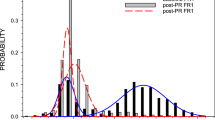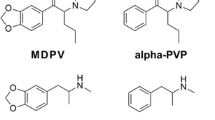Abstract
In general, the effects of 8-OH-DPAT on the body temperature of rats or in inducing the 5-HT syndrome show rapid tolerance. However, in contrast, the 8-OH-DPAT-induced increase in the activity of rats in a two-way active avoidance task only occurs after repeated administration, i.e. there is sensitisation. The present study was conducted to examine whether this developing hyperactivity may also be expressed as increased rates of lever press responding, and if so, under which conditions it occurs. Rats were trained to press levers under fixed interval 60-s (FI 60) or differential reinforcement of low rates 20-s or 72-s (DRL20, DRL72) schedules of food reinforcement. Groups of trained rats were then treated daily 5 min before testing with doses of 0.01, 0.1 and 1.0 mg/kg 8-OH-DPAT SC for 10–21 days. In all three procedures, in the first couple of days of drug treatment, 8-OH-DPAT generally suppressed lever pressing in a dose-dependent manner. Thereafter, tolerance to this effect was seen to a greater (DRL20, DRL72) or lesser (FI60) extent. Some evidence for stimulation of low rates of lever press responding was seen after 10 days treatment under FI60, but not in DRL20 or DRL72 during short 30 to 60 min long daytime tests although in the latter case, the rats responded to the stimulating effects of 0.8 mg/kg SC amphetamine administered once at the end of the experiment. However, when rats were allowed to respond under DRL72 testing for 12 h during the night, after 10 days treatment a clear stimulation of lever pressing was observed. This stimulation was not specific to lever pressing, however, since a stimulation of entries into the food tray and licking were also seen. From these results, it may be concluded that the stimulating effect of 8-OH-DPAT after repeated administration may be expressed as increased rates of lever pressing, but not under all conditions in which psychomotor stimulation by amphetamine is seen. The potential for 8-OH-DPAT and related compounds to stimulate motor responding in this way should be taken into account when interpreting the effects of these drugs in animal models of psychiatric disorders.
Similar content being viewed by others
References
Ahlenius S, Larsson K (1987) Evidence for a unique pharmacological profile of 8-OH-DPAT by evaluation of its effects on male rat sexual behavior. In: Dourish CT, Ahlenius S, Hutson PH (eds) Brain 5-HT1A receptors. Horwood, Chichester, pp 185–198
Björk L, Fredriksson A, Hacksell U, Lewander T (1992) Effects of (R)-8-OH-DPAT and the enantiomers of UH-301 on motor activities in the rat: antagonism of (R)-8-OH-DPAT-induced effects. Eur J Neuropsychopharmacol 2:141–147
Cervo L, Samanin R (1987) Potential antidepressant properties of 8-hydroxy-2-(di-n-propylamino)tetralin (8-OH-DPAT), a selective serotonin1A receptor agonist. Eur J Pharmacol 144:223–229
Dews PB, Wenger GR (1977) Rate dependency of the behavioral effects of amphetamine. In: Thompson T, Dews PB (eds) Advances in behavioral pharmacology, vol. 1. Academic Press, New York, pp 167–227
Dourish CT, Hutson PH, Curzon G (1985) Low doses of the putative serotonin agonist 8-hydroxy-2-(di-n-propylamino)tetralin (8-OH-DPAT) elicit feeding in the rat. Psychopharmacology 86:197–204
Ebenezer IS (1992) Effects of the 5-HT1A agonist, 8-OH-DPAT, on operant food intake in non-deprived rats. NeuroReport 3:62–64
Engel JA, Hjorth S, Svensson K, Carlsson A, Liljeqvist S (1984) Anticonflict effect of the putative serotonin receptor agonist 8-hydroxy-2-(di-n-propylamino)tetralin (8-OH-DPAT). Eur J Pharmacol 165:365–368
Ensler K, Ryan CN, Evenden JL (1993) Effects of repeated treatment with 5-HT1A agonists on active avoidance responding in the rat. Psychopharmacology 112:45–54
Evenden JL (1992) Effects of 8-hydroxy-2-(di-n-propylamino)tetralin (8-OH-DPAT) after repeated administration on a conditioned avoidance response (CAR) in the rat. Psychopharmacology 109:134–144
Evenden JL, Ängeby-Möller K (1990) Effects of 8-hydroxy-2-(di-n-propylamino) tetralin (8-OH-DPAT) on locomotor activity and rearing of mice and rats. Psychopharmacology 102:485–491
Fletcher PJ (1993) A comparison of the effects of dorsal or median raphe injections of 8-OH-DPAT in three operant tasks measuring response inhibition. Behav Brain Res 54:187–197
Fletcher PJ (1994) Effects of 8-OH-DPAT, 5-CT and muscimol on behaviour maintained by a DRL20 schedule of reinforcement, following microinjection into the dorsal or median raphe nuclei. Behav Pharmacol 5:326–336
Giral P, Martin P, Soubrié P, Simon P (1988) Reversal of helpless behavior in rats by putative 5-HT1A agonists. Biol Psychiatry 23:237–242
Goodwin, GM, Green AR (1985) A behavioural and biochemical study in mice and rats of putative selective agonists and antagonists for 5-HT1 and 5-HT2 receptors. Br J Pharmacol 84:743–753
Goudie AJ, Leatchley M, Deans, C, Taylor MAI (1989) Tolerance to the behavioural effects of the selective 5-HT1A agent, ipsapirone. Behav Pharmacol 1:33–44
Hillegaart, V, Wadenberg, M-L, Ahlenius S (1989) Effects of 8-OH-DPAT on motor activity in the rat. Pharmacol Biochem Behav 32:797–800
Johansson CE, Meyerson BJ (1991) The effects of long-term treatment with 8-OH-DPAT on the lordosis response and hypothermia in female rats. Eur J Pharmacol 196:143–147
Johansson CE, Meyerson BJ, Höglund AU (1990) The long-term effects of 8-hydroxy-2-(di-n-propylamino)tetralin (8-OH-DPAT) on copulatory and exploratory behaviour in male rats. Eur J Pharmacol 178:1–9
Kennett GA, Marcou M, Dourish CT, Curzon G (1987) Single administration of 5-HT1A agonists decreases 5-HT1A presynpatic but not post-synaptic receptor-mediated responses: relationship to antidepressant-like actions. Eur J Pharmacol 138:53–60
Larsson L-G, Rényi L, Ross SB, Svensson B, Ängeby-Möller K (1990) Different effects on the responses of functional pre- and post-synaptic 5-HT1A receptors by repeated treatment of rats with the 5-HT1A receptor agonist 8-OH-DPAT. Neuropharmacology 29:85–89
Marek GJ, Li AA, Seiden LS (1989) Evidence for involvement of 5-hydroxytryptamine1 receptors in antidepressant-like drug effects on differentia-reinforcement-of-low rate 72-second behavior. J Pharmacol Exp Ther 250:60–71
Montgomery AMJ, Willner P. Muscat R (1988) Behavioural specificity of 8-OH-DPAT-induced feeding. Psychopharmacology 94:110–114
Montgomery AMJ, Rose IC, Herberg LJ (1991) 5-HT1A agonists and dopamine: the effects of 8-OH-DPAT and buspirone on brain-stimulation reward. J Neural Transm [GenSect] 83:139–148
Rényi L, Ängeby-Möller K, Ensler K, Evenden JL (1992) The noncompetitive NMDA receptor antagonist (+)MK-801 counteracts the long-lasting attenuation of the hypothermic response induced by acute doses of 8-OH-DPAT in the rat. Neuropharmacology 31:1265–1268
Ryan CN, Evenden JL, Pettersson M (1993) Effects of buspirone on schedule-induced polydipsia: a comparison with ipsapirone, 8-hydroxy-2-(di-n-propylamino)tetralin (8-OH-DPAT) and raclopride. Psychopharmacology 112:34–44
Sanger DJ (1988) Theα 2-adrenoceptor antagonists idazoxan and yohimbine increase rates of DRL responding in rats. Psychopharmacology 95:413–417
Tricklebank MD, Forler C, Fozard JR (1984) The involvement of subtypes of the 5-HT1 receptor and of catecholaminergic systems in the behavioural response to 8-hydroxy-2-(di-n-propylamino)tetralin in the rat. Eur J Pharmacol 106:271–282
Author information
Authors and Affiliations
Rights and permissions
About this article
Cite this article
Evenden, J., Ryan, C. & Palejko, W. The effects of repeated treatment with 8-hydroxy-2-(di-n-propylamino)tetralin (8-OH-DPAT) on the lever press responding of the rat under FI and DRL schedules of food reinforcement. Psychopharmacology 120, 81–92 (1995). https://doi.org/10.1007/BF02246148
Received:
Revised:
Issue Date:
DOI: https://doi.org/10.1007/BF02246148




